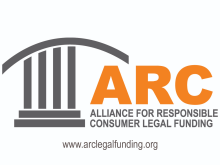The legal funding industry has grown rapidly in recent years, offering innovative solutions to plaintiffs, law firms, and businesses involved in litigation. Most legal financing can be categorized into one of three types:
- Consumer legal funding
- Commercial litigation financing, and
- Attorney portfolio financing.
While all three provide much-needed financial resources during legal proceedings, they operate in different spaces, serve different clients, and are structured differently. Understanding the distinctions among these funding mechanisms is vital for attorneys, clients, lawmakers, and legal professionals.
Applying a uniform regulatory approach to all forms of legal funding, lawmakers and regulators causes unintended, and potentially irreparable, harm to vulnerable consumers and to broader access to justice.
Consumer Legal Funding: Supporting Individual Plaintiffs and Not the Lawsuit
Consumer legal funding, or “pre-settlement funding,” is designed specifically for individuals involved in personal injury or civil litigation. These plaintiffs often find themselves in financially precarious situations due to injuries that prevent them from working or increased costs resulting from medical treatment or legal battles. Traditional sources of credit (like banks and credit cards) are often unavailable to these people, especially if they have poor credit or no income. This is because the funder’s underwriting/approval process focuses on the case's merits, not the plaintiff’s credit score, employment status, or income.
Consumer legal funding provides money to plaintiffs for household needs, such as paying rent, utilities, and groceries. This funding is not used to finance the lawsuit itself. Instead, it ‘fills the gap’ between filing a lawsuit and when a plaintiff is paid on that lawsuit. In exchange, the funder becomes contractually entitled to a portion of the expected settlement or judgment. The funds are non-recourse, meaning that if the plaintiff loses or has insufficient funds from settling the case to pay the funder, the plaintiff owes the funder nothing. This is a crucial distinction from a loan, which must be repaid regardless of outcome.
Critics of consumer litigation funding point to its cost. But from the perspective of a plaintiff with bills to pay and no other way to keep the lights on, it can mean the difference between justice and just giving up. Without it, many are cornered into taking the first insultingly low settlement offer that comes their way. Consumer legal funding lets them hold out. It gives them a fighting chance to see a case through instead of being strong-armed into walking away with pennies on the dollar.
Commercial Litigation Financing: Empowering Corporate Plaintiffs and Defendants
In contrast to consumer legal funding, commercial litigation funding caters to businesses pursuing claims such as breach of contract, intellectual property disputes, antitrust claims, fraud, or international arbitration.
Commercial litigation is often complex, high-stakes, can take years to resolve, and is notoriously expensive. Commercial litigation funders provide money to pay legal fees, expert witnesses, discovery, depositions, and trial preparation. Such expenses can place a significant financial burden on a company. Commercial litigation financing helps alleviate this burden by providing capital in exchange for a share of the proceeds if the case is successful.
Unlike consumer legal funding, which is standardized and relatively small (typically a few thousand dollars on average), commercial litigation financing is generally customized, contractually sophisticated, and may involve millions of dollars. Funders conduct extensive due diligence before offering capital. This includes analyzing legal filings, reviewing contracts, evaluating case law, and estimating potential damages and recovery rates.
Plaintiff-company for two reasons. First, it allows them to use their capital to pursue their core business instead of litigation. Second, it levels the battlefield when a plaintiff would otherwise be ‘outgunned’ by a well-funded defendant.1
Attorney Portfolio Financing: Strengthening Law Firms' Stability and Growth
A third form of legal funding is attorney portfolio financing. Taking a step back, this term is used in both the consumer and commercial contexts, but I use it here to refer only to its use on the consumer litigation side.
Contingency-fee attorneys representing consumer plaintiffs commonly face cash flow challenges because they represent clients without upfront payment and are only paid if and when they win or settle a case.
Attorney portfolio financing helps address this issue by enabling law firms to leverage the value of multiple ongoing cases to secure funding. This is typically accomplished by a funder providing a loan (e.g., a revolving credit facility or term loan), with the attorney’s contingency fees for a group (portfolio) of the attorney’s cases serving as collateral. Repayment is tied to the resolution of the cases in the portfolio (i.e., the funded cases).
Of course, a lender in this context can offer better terms to a law firm than if the collateral were just a single case because of the diversification the portfolio provides. The loan proceeds can typically be used for all sorts of things beyond case-specific expenses, including overhead.
Clarifying Misconceptions
There is a commonly held misconception that lawsuits filed by individual consumer plaintiffs are funded by litigation funding. As explained above, however, consumer plaintiffs receive small amounts of money to pay for their living expenses, and their attorneys are paid, if at all, on contingency. This means the attorney covers the legal costs and is only compensated if the case results in a favorable settlement or judgment. Consumers are not required to provide any upfront funding to retain legal representation.
On the other hand, portfolio financing is a tool that contingency attorneys use to manage cash flow.
This vital distinction underscores the need for accurate classification and regulation within the legal funding space. Lumping consumer legal funding with commercial or portfolio-based financing under one regulatory framework risks misunderstanding each model's structure, purpose, and beneficiaries.
To Be Clear, Different Stakeholders, Different Needs
Consumer legal funding helps injured or financially distressed individuals cover essential living expenses during ongoing litigation. These people often lack access to credit and are in vulnerable positions. Funds are not used to pay for litigation expenses.
Conversely, Commercial litigation funding serves businesses involved in multimillion-dollar disputes, often with access to sophisticated legal counsel and internal legal budgets.
Attorney portfolio financing supports law firms with contingency-based practices, providing them with working capital to take on more clients or withstand lengthy litigation timelines.
This chart summarizes some of the differences:
| Feature | Consumer Legal Funding | Commercial Litigation Financing | Attorney Portfolio Financing |
|---|---|---|---|
| Primary Client | Individual plaintiffs | Businesses (SMEs to large corporations) | Law firms (especially contingency-based practices) |
| Purpose of Funds | Living expenses (rent, food, utilities) | Legal fees, experts, trial prep | Litigation costs, staffing, marketing, operations |
| Repayment Obligation | Non-recourse: No repayment if case is lost or insufficient proceeds out of the settlement | Repayment if successful | Tied to resolution of multiple cases (pooled risk) |
| Average Amount | A few thousand dollars | Often in millions | Varies widely; often large and flexible |
| Due Diligence Focus | Strength of the case | Deep legal & financial review | Aggregate case portfolio evaluation |
| Fund Structure | Single-case, standardized | Custom | Portfolio-based, often revolving credit or term loan |
| Access to Legal Representation | On contingency fee basis | Businesses with internal or retained counsel | Law firms seeking capital stability & growth |
| Risk to Funder | High (due to single-case outcome dependency) | Moderate to high (based on case size & complexity) | Moderate to high (due to case diversification) |
| Common Misconception | Funds used to pay legal expenses | Funds used to pay for litigation | Consumers initiate portfolio-funded suits |
Conclusion
Each of these financing models plays a distinct and vital role in expanding access to justice, supporting fairer outcomes, and sustaining the legal system’s functionality. As the legal finance industry continues to evolve, so too does the need for clear definitions, thoughtful oversight, and regulatory frameworks that reflect each model's unique characteristics.
Although uniform legislation may appear efficient, it is a blunt and often counterproductive tool when applied across such a diverse landscape. Treating all legal funding models the same without regard for their differences in scale, structure, and beneficiary risks undermines the very goals such regulation intends to achieve.
What protects a consumer might cripple a law firm. What governs institutional capital might be irrelevant or even harmful— an injured individual seeking a fair settlement.
1 For a comprehensive discussion of commercial litigation funding, see Jonathan Friedland & Jeremy Waitzman, Litigation Funding: A Guide for Plaintiffs & Commercial Litigators Seeking Funding in the United States (Financial Poise, February 13, 2024), at Section 1.6 (available here) (“Just as a company that makes widgets may decide to enter into a sale/leaseback transaction on the basis, in part, that it is not a landlord and its time is not best spent doing ‘landlord things,’ and just as some owners of popular consumer brands that used to manufacture their products later evolved to become marketing-only companies that today rely on contract manufacturers because marketing is what they do best, so too might a company decide that investing capital outside its core competency does not present a highest and best use of its capital… [It] is [also] sometimes sought by Fundees who lack the financial resources to pursue legal claims against a third party… [It] can thus fulfill the needs of parties that cannot afford to pay attorneys by the hour, and law firms that cannot or will not take on a wholly contingent basis. In this way, litigation funding can help level the playing field in disputes involving large, well-funded defendants (think ‘David vs. Goliath’).”




 />i
/>i
